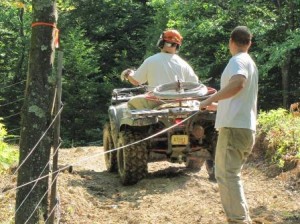
EMPORIUM – Deer exclosures are routinely installed on state forest land to protect young trees and plants from excessive browsing and help establish a new forest, according to District Forester Jeanne Wambaugh.
She explained that some fenced areas quickly show dramatic differences from areas outside the fence while others take longer to yield results. Responses in new growth, she said, can vary depending on soil type, seed source, the presence of invasive species and other environmental factors.
“Seedlings severely browsed may never reach beyond feeding deer and will eventually die from the repeated stress. One deer can eat four to 10 pounds of browse a day,” said Wambaugh.
According to her, raspberries and blackberries are highly preferred by deer and are an important food source for many forest dwellers. Abundant raspberry and blackberry bushes can be one indicator of a healthy forest understory.
She added that the presence or absence of some common wildflowers can be key indicators of the level of deer impact on a given forest site. Deer in Pennsylvania typically do not eat ferns, she said.
Wambaugh said that forests with understories dominated by ferns indicate degraded habitat and could mean deer populations are not balanced with habitat conditions.
The Elk State Forest has 104 fences installed to establish forest regeneration and create plant diversity, she said. This year, she said that nine woven wire fences were removed by a contractor and one was removed by staff. She said that three woven wire fences were installed by contractors and three electric were installed by staff members.
Wambaugh explained that a woven wire fence is more expensive to install and remove. She said it is installed for slower growing species, like oak and will remain for five to 10 years or more. Wambaugh said that an electric fence costs considerable less to install and remove, and is used for faster growing species like red maple and aspen.
“So try to identify the tree species inside the next fence you walk by,” she said. “Take a look at the vegetation on the forest floor, like wildflowers and ground cover, than take a look at the vegetation outside of the fence. Can you notice the difference the fence makes?”



